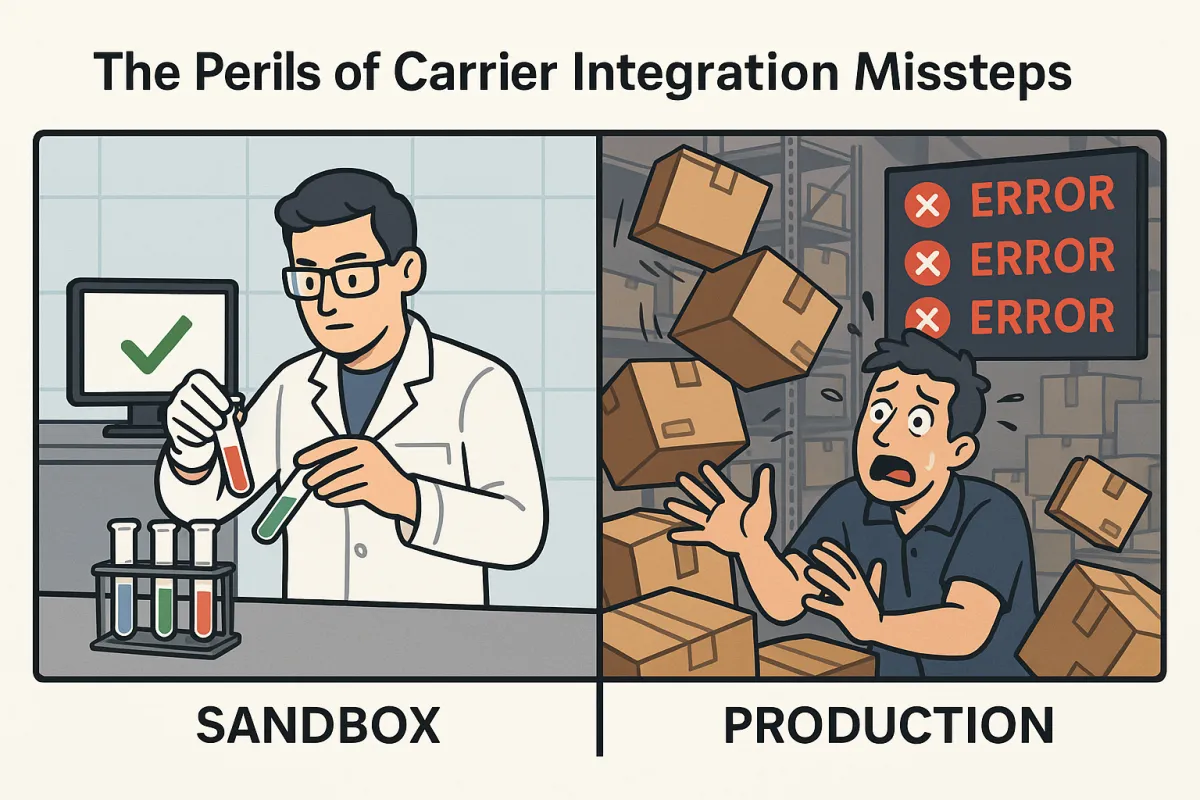Carrier Integration Testing: Why Your Sandbox Success Becomes Production Failure

Last month, an e-commerce platform went live with their new UPS integration. The rates that you get in the sandbox may not match the rates that you get in production. Any negotiated rate discounts that you have are not applied in the sandbox and some rates are "dummy" rates to prevent abuse of our sandbox for production purposes. Customers saw shipping costs jump by 40% overnight, orders plummeted, and the platform had to roll back their integration within hours.
Sound familiar? You're not alone. 58% of organizations monitor their APIs less than daily and lack confidence in inventory accuracy. Only 20% have achieved real-time monitoring, leaving most vulnerable to security threats. When it comes to carrier integration testing, what works perfectly in sandbox often breaks spectacularly in production.
Authentication Inconsistencies: OAuth vs Legacy Methods
Here's where things get messy. FedEx's shipping API uses the OAuth 2.0 authentication method to verify API requests. UPS has stopped issuing API access keys and implemented OAuth 2.0 authentication. But here's what the documentation doesn't tell you: sandbox and production environments often use completely different authentication flows.
If you're verifying authentication on a sandbox organization, use "test.salesforce.com" instead of "login.salesforce.com" in all the OAuth endpoints listed above. This pattern repeats across carriers. Your sandbox OAuth implementation that worked flawlessly might use entirely different endpoints, token refresh mechanisms, or scope requirements in production.
Take FedEx's multi-package shipping. The multi-package shipping feature does not work with FedEx in the sandbox. You'll receive the error A shipping carrier error occurred: Unable to create FedEx shipment. Unable to retrieve record from database. when attempting a multi-package shipment with FedEx. You can spend weeks perfecting your integration, only to discover critical features simply don't exist in the test environment.
Platforms like Cargoson, EasyPost, and nShift attempt to normalize these differences by providing unified authentication layers. But direct carrier integrations? You're on your own to navigate the authentication maze between sandbox and production.
Rate and Service Mismatch: The Hidden Costs
Remember that e-commerce platform disaster? The root cause was simple: Sandbox accounts will not necessarily have the same rates you see in your production carrier accounts. As these are test accounts, the rates do not reflect what you will see when you move to the Production environment and begin using your actual connected carriers.
The impact is brutal. Even a small business can negotiate at least 75% discount on this, as we have. If the customer sees an automated price of £100 they will not place an order so we absolutely need for them to see the discounted rate. Your customers see retail rates that could be 3-4x higher than your negotiated discounts.
But it gets worse. For tiered rates and promotional discounts, if a particular shipment based on zone, origin, destination or even shipment size doesn't qualify for the existing discount then no negotiated rates container will be returned. Published rates will be the applicable rate. Even when your production integration correctly requests negotiated rates, edge cases in zone restrictions or package dimensions can fall back to retail pricing.
In high-volume shipping, small discrepancies add up fast. A label quoted at $9.80 might invoice at $12.40 due to surcharges, weight adjustments, or address changes. Shippo's API supports carrier invoice reconciliation, comparing the quoted cost at purchase with the final carrier invoice after delivery. This reconciliation gap is invisible in sandbox testing but costs real money in production.
Sandbox Limitations That Break Production Workflows
Tracking, even in the sandbox environment, requires real packages to be in the mailstream. ShipStation API doesn't currently provide a way to simulate tracking events in the sandbox. Think about that. Your carefully crafted tracking notifications, delivery status updates, and exception handling? None of it can be properly tested.
The performance gap is equally problematic. The sandbox environment has a 20 requests per minute rate limit, which is significantly lower than our production environment. The ShipStation API sandbox uses development environments provided by the carriers. Those development environments can sometimes be significantly slower than production environments, so you may see longer response times in the sandbox. Rest assured that you will see much faster performance in production.
Here's what you can't test in most carrier sandboxes:
- Webhooks and workflows that require webhooks (such as batching) are not available in the sandbox environment. Branding features, such as Branded Labels and Branded Tracking Pages, are not currently available in the sandbox.
- The sandbox only supports the three major US parcel carriers -- UPS, FedEx, and USPS (Stamps.com).
- Real-world carrier downtime and failover scenarios
- Peak season surcharges and capacity constraints
At present, FedEx does not support test mode and requires a FedEx account specifically setup for testing. Contact your FedEx account manager for support in setting up a FedEx test account. Good luck getting that approved for your development team's testing cycle.
Security and Monitoring Blind Spots
The security picture is alarming. It was found that 30,000 Postman workspaces had been exposed, containing live API keys, access tokens, and sensitive payloads (including healthcare records and enterprise credentials). What went wrong: Many workspaces were publicly shared without security controls. Developers had saved real tokens, secrets, and request logs that were accessible to anyone with the link. Why it matters: Postman is used across the API lifecycle, but it's not designed as a secret manager. One exposed workspace could give attackers direct access to production systems.
95% of API attacks came from authenticated sessions, suggesting that simply trusting access tokens is no longer enough. Your sandbox testing might validate basic authentication flows, but it can't simulate the sophisticated attacks happening in production.
Long-lived tokens increase the window for replay or theft. Why: UX tradeoffs, use of single master tokens instead of session tokens, missing refresh patterns, and no risk-tiered TTLs. Fix: Shorten access token lifetimes, introduce refresh tokens, and apply shorter TTLs for high-risk scopes. Yet most sandbox environments use simplified, long-lived tokens that mask these security requirements.
Best Practices for Robust Integration Testing
Confirm that you're testing the API version you plan to use in production. Different versions of an API are occasionally incompatible with one another; you can mitigate this risk by simply using the same versions in your production and testing environments. This seems obvious, but version mismatches are a leading cause of production failures.
Here's your testing strategy:
Phase 1: Sandbox Foundation
When creating a sandbox environment for developers, it is important to ensure that it closely mimics the behavior of the real production system. This similarity allows developers to test their integrations with confidence, knowing that the sandbox will behave the same as the actual production API. Without this assurance, developers would need to repeat their testing using the real API, which undermines the purpose of having a sandbox.
Phase 2: Limited Production Validation
Live API tokens should be used for final testing before a launch and will allow a partner to complete real world end to end testing, including purchase, tracking, and refunding of live labels. Create small test shipments with actual addresses to validate the complete flow.
Phase 3: Authentication Hardening
Even though it's a testing environment, developers still need to practice the same security steps they would use in production. If your API uses keys, tokens, or OAuth in the live environment, your sandbox should require them too. This helps developers prepare for real-world security requirements.
Platform Solutions and Workarounds
Unified platforms tackle these gaps differently. Cargoson creates a universal API standard that equalizes service levels across carriers, abstracting away the sandbox-production inconsistencies. EasyPost returns your negotiated rates from the following carriers by maintaining both sandbox and production connections simultaneously.
ShipEngine (now ShipStation API) matches the production environment as much as possible, but there are a few differences to be aware of. The sandbox only supports the three major US parcel carriers -- UPS, FedEx, and USPS (Stamps.com). Their approach focuses on feature parity over carrier coverage.
When evaluating platforms like nShift, FreightPOP, or Blue Yonder against direct integrations, ask these questions:
- How do they handle rate reconciliation between quoted and billed amounts?
- Do they provide production-like tracking simulation?
- Can they replicate your exact carrier authentication requirements?
- How do they manage carrier-specific feature limitations in sandbox?
The choice between aggregators and direct carrier connections often comes down to control versus convenience. Direct integrations give you full access to carrier-specific features but require you to handle all the sandbox-production gaps yourself. Platforms like Manhattan Active or Transporeon provide standardization but may abstract away features you need.
The million-dollar integration gap isn't going away. Carriers have little incentive to perfect sandbox environments when their revenue comes from production labels. 58% of organizations monitor their APIs less than daily and lack confidence in inventory accuracy. Only 20% have achieved real-time monitoring, leaving most vulnerable to security threats.
Your next integration doesn't have to fail in production. Build comprehensive testing that spans sandbox validation, limited production testing, and continuous monitoring. Because in carrier integrations, what you can't test in sandbox will definitely surprise you in production.




